The Story
Chateau Biac’s unique setting overlooking a meander of the Garonne River and the plain of the Graves, has not been a timeless witness merely to the region’s history, but also to the geological movements of the area, now embedded in its unique terroir.
Archived by the Feret Editions as a wine producing estate since their second publication in the mid-19th century, its history goes back much further in time to the Roman era, when the Romans brought vines with them to the Aquitaine and planted the first vineyards in the area around Biac.
Story of the Estate: 17th to 20th century

In the 17th century, Biac was spread over 37 hectares of land, more than double the current area of 15 hectares. The architecture of the present day winery suggests that part of it may have been used as a barn to store grain and to house cattle.
“Le Vieux Biac”, today’s guesthouses, was the original “Château” with its agricultural buildings next to it, now offices and entertaining rooms.
The present day Château (cf. print) was built in 1755 by the daughter of the Baron of Langoiran who owned Biac. The stones to build it most probably came from the quarry in our woods as was often the case in those days.
In 1820, Biac was sold to the Mayor of Langoiran, Mr Gregoire Andrieu. His family and their descendants, the Bassal Andrieu, established Biac’s reputation for excellence well into the 20th century: “The vines for the white wine came from Château d’Yquem, whilst those for the red came from the very finest Châteaux in St Emilion” and the wines from the Estate started to be known for “… class, finesse, ranked amongst the very first growths of the commune”, Bordeaux et ses vins , Editions Feret, 1874 and 1893.
Sometime during the 19th century, the family added the imposing square shaped tower to the 18th century body of the house.
Biac and the Garonne River
Although the name “Biac” remains an enigma, it may refer to its proximity to the Garonne river (Acqua in Latin) ; it could also derive from the Latin suffix “ac”, meaning “at”. Any historians out there reading this chapter? Feedback is welcome!
Close to an important intersection of four main Roman roads, Biac also features on the 18th century renowned Cassini family maps of France, commissioned by King Louis XVI prior to the French revolution.
Its eagle nest location not far from the medieval Castle of Langoiran explains the presence of a watch tower now hidden by the overgrowth in our woods.
From ancient times to the early 20th century, the Garonne River was the “Highway” between the Atlantic Ocean and the Mediterranean Sea, linking Bordeaux to Marseille via the “Canal du Midi” which begins close to Langon. From its vantage point, Biac looked at ships ferrying goods to and from the Bordeaux harbor.
This century the river retained that practical use as it was used to ferry parts of the A380 Airbus on their journey from Bordeaux’s harbour to Langon, where they were unloaded then trucked by special convoy to Toulouse for assembly. It was an extraordinary sight to watch them day or night, glide past our terrace on the river…and imagine the assembled planes flying over our heads!

More recently

Biac was sold in the late 1960s, to Frederic Bonnard, oenologist and a relative of the famous painter Pierre Bonnard. In 1977, it was acquired by Paul and Marie Helene Ducatez (cf. photo).
Following her untimely death, the Schroeder Rossini family bought Château Biac in 1995 and owned it until 2006, when we acquired it.
Who are we?
We are a Lebanese family. The travel bug and inquisitive character inherited from our ancestors, the Phoenicians, seems to have succeeded in adding Langoiran to our already varied home destinations. Tony and Youmna started the story in 2006. Yasmina joined as marketing director in 2013 and Gabriel took charge of the production in 2019. Antonia and Nickyl, her husband, provide much needed encouragement and support.
How we became “accidental winemakers” is another story, best heard by coming to visit us…However, as we made the plunge, we also committed to revive and perpetuate the Biac legacy of excellence, to ensure that Château Biac regains and then remains one of the finest properties of the region at the centre of Bordeaux ‘s history of fine wines.
